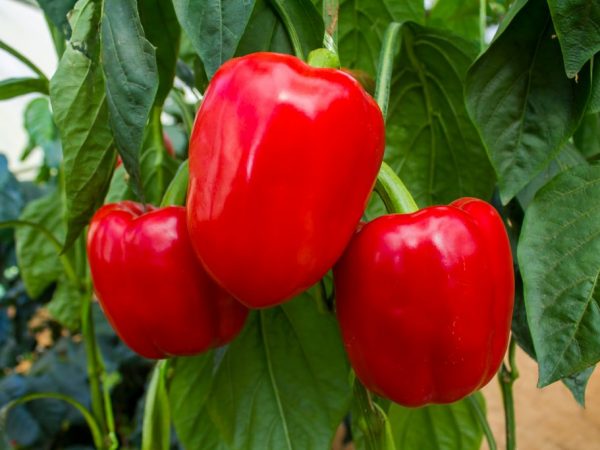Description of pepper Tenderness
Pepper Tenderness gained its popularity, first of all, due to its ability to give good harvests even in the conditions of Siberia and the North-West region. The variety was bred a long time ago, but to this day it is among the best.
Characteristic
Depending on the growing conditions, Tenderness pepper belongs to the early or medium early varieties. On average, the first fruits can be harvested 110-125 days after germination.
Greenhouse conditions are best suited for growing varieties of sweet pepper Tenderness, but it is possible to cultivate it in open beds, if climatic conditions permit.
The yield of pepper Tenderness is high enough. The fruits have a pleasant, delicate taste. They are used both for canning, stewing, stuffing, and for preparing salads and eating raw. The fruits are rich in vitamins and carotene, are used for insomnia, lack of energy and even diabetes.
Description of the bush
The plant is medium-tall (about 80 - 100 cm) and quite compact. A garter on a support is required, especially during the fruiting period, so that the bush can withstand the weight of the fruit. The leaves have a rich green color and are relatively rare on the plant.
Description of the fetus
Pepper fruit characteristic Tenderness: the fruit has an elongated pyramidal shape with a blunt tip. The size is medium, weight is about 100 grams. They are attached with short stalks that are easy to break off. When technically ripe, they have a pale green color, which changes to a rich red color with the onset of biological maturity.
The wall thickness is 7 to 9 mm. The skin is very strong and elastic, although it is quite thin. The pulp is dense and very juicy, has a delicate taste and pleasant smell.
Benefits
The advantages of the Tenderness pepper variety include:
- good seed germination;
- early maturity;
- immunity to many diseases;
- good fruit taste and versatility of their use;
- abundant productivity;
- the ability to bring good harvests even in the regions of the Urals and Siberia;
- richness of nutrients and vitamins.
Sowing seeds and planting

We grow large peppers
The optimal period when the Tenderness pepper seeds should be sown is considered the end of February - the beginning of March (depending on climatic conditions). First you need to prepare a suitable soil that will facilitate early germination.
It is better to pickle the seeds by treating them with special agents. For this, a twenty-minute disinfection with a manganese solution or soaking in EPIN for 17-18 hours is well suited. Then the seed is washed with water and germinated on a damp cloth.
Seedling preparation
Until the moment of planting, the seedlings should get stronger, therefore, it is recommended to transplant no earlier than after 90 days. Before that, it is necessary to monitor the level of its lighting and, if necessary, use additional light.A few weeks before planting, you should start hardening the seedlings by gradually lowering the temperature. This is necessary in order to make it easier for her to adapt to more severe conditions.
If grown in greenhouses, seedlings can be planted at the end of May, in open ground at the beginning of June. The average daily temperature should not fall below 14 °, since cold snaps and temperature drops significantly slow down the growth of plants. No more than 5 to six bushes should be placed on one square meter.
Care and fertilization
Sweet pepper Tenderness needs frequent but moderate watering, which is to moisten the soil. To do this, use warm, settled water. After watering, you need to loosen the soil a little well and remove all weeds. It is impossible for water to get on the ovaries, fruits and leaves, as this can provoke them to fall off and have a bad effect on the bush itself.
The variety responds well to various feedings. To accelerate the growth of seedlings, complex fertilizers with an ash content in the form of solutions are used, which are sprayed on plants. After transplantation, nitrogen fertilizers are used, and during the fruiting period, potassium-phosphorus fertilizers are used.
Plants of this species need a garter. But do not forget about the removal of side shoots and some leaves from below, but this must be done gradually so as not to injure the bush very much.
No more than fifteen ovaries should be left on one plant. The fruits are harvested at the stage of technical maturity, after which they are left to ripen in a dry and warm room.
It is important to constantly monitor the humidity and temperature control. Overcooling of plants should not be allowed.
Possible diseases
The variety is not prone to infections and disease, even such common ones as white rot and late blight. As a preventive measure, you should regularly remove weeds from the beds, avoid overflows, do not water the plants with cold water, and regularly feed them.
It is also necessary to disinfect the seeds before planting so that the plants are not attacked by aphids and other pests.
Conclusion
Description of the pepper variety Tenderness makes it possible to understand that he is among the leaders. This is confirmed by the wonderful sweet taste of the fruit, and abundant yield, and resistance to diseases.
It must be remembered that Tenderness is suitable for growing only for those who have enough time to care for it. Otherwise, the plants will start to hurt, grow poorly, and there can be no talk of a good harvest.


